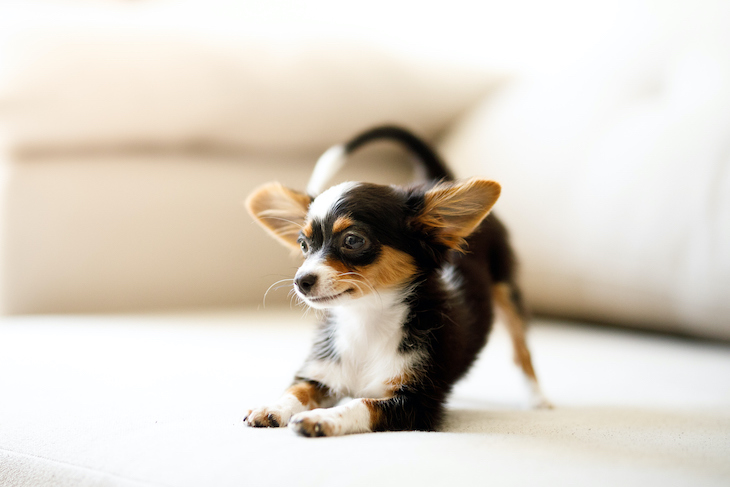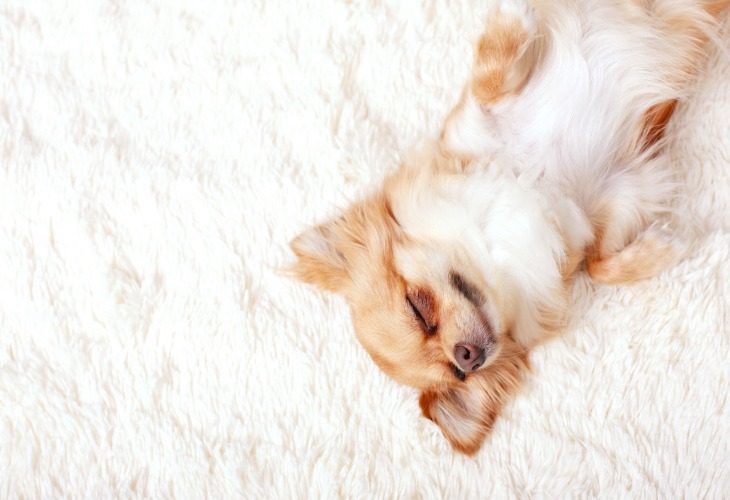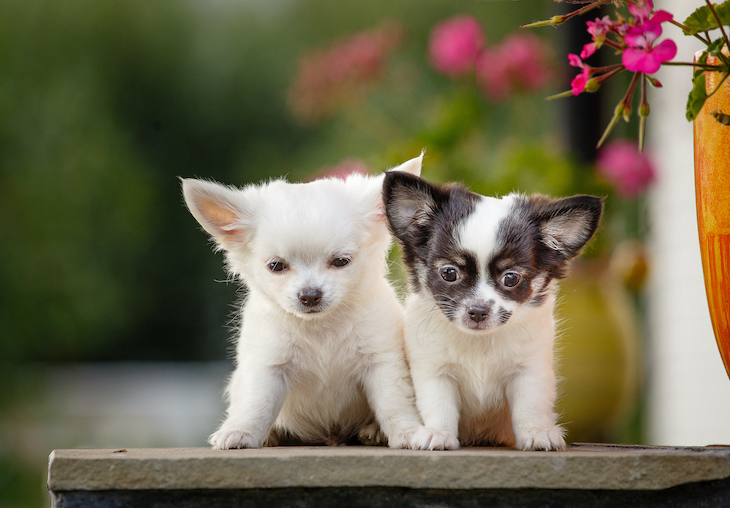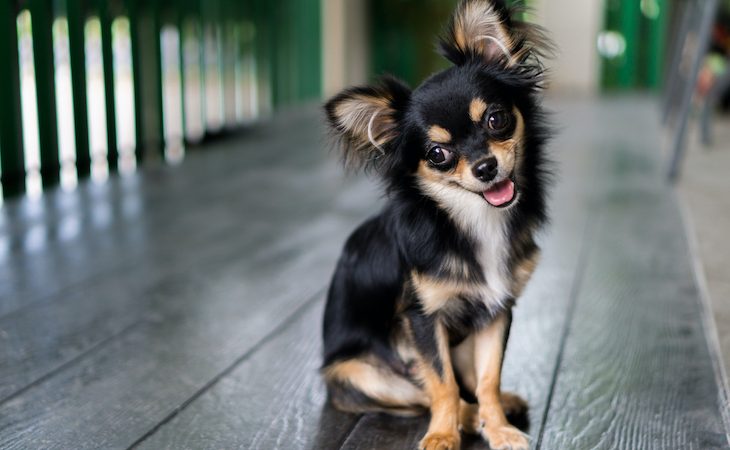Breed standard: AKC, CCA, FCI, LOOF I Size: Small I Average lifespan: 15-20 years I Temperament: Sassy and self-important I Coat length: Short / long I Origin: Mexico
Origins of the Chihuahua
Mexican, Asian or European?
Chihuahua – it’s the name given to one of Mexico’s most northern states as well as the state’s capital city. It’s also the name given to the world’s smallest dog breed being largely associated with Chihuahua City.
Strange then that the origins of the Chihuahua have been much debated. So from where then does the Chihuahua originate? From breed introductions coming from Europe or Asia? Or indeed from Mexico? Or a combination?
It turns out that archaeological research has concluded that the Chihuahua has its roots in Mexico with influences from Asia. Traces of ancient civilizations show that indigenous groups from both geographical regions bred dogs whose physique was very similar to today’s Chihuahua. However, it is believed the strongest and earliest presence of DNA belonging to the Chihuahua hailed from Mexico City.
In Central America, near El Salvador in Mexico City, ancient ‘toys’ representing Chihuahuas were discovered as part of archaeological excavations in the region. The first objects found dated from 100 years AD near Veracruz in Mexico. The discovery shows that the breed existed on these lands long before the arrival of the first settlers, thus eliminating purported origins of Europe or Asia.
An ancient breed shrouded in deity
The breed traces back to the time of the Toltecs who ruled over Mexico about 1,000 years ago. The Toltecs were subsequently conquered by the Aztecs who were a sophisticated ruling people during the 14th and 15th centuries. Following the fall of the Toltec people, the Aztecs adopted many of their indigenous qualities and possessions, including the Téchichi dog. Although slightly larger and heavier than today’s Chihuahua, the Chihuahua was bred down to its smaller size we know today, although still larger than we know today. Their ears were also larger.
A small dog resembling the Chihuahua was found to be referenced in various Aztecs legends. Here the stories spoke of the Chihuahua’s deity and treatment as an almost God-like creation. According to their beliefs, the Chihuahua held the power to absolve sins. The Aztecs believed that the company of a Chihuahua was essential at the end of their lives to cross the gates of Paradise. When the dog died, it was apparently buried with its deceased master whose sins were then transferred to the dog as a form of religious reckoning. The Chihuahua then guided the soul of the deceased to the other world.
Conquering the world
Following the collapse of the Aztec Empire by the Spanish conquistadors, the Chihuahua slipped into obscurity. The breed remained but was largely out of sight of large cities.
The Chihuahua made its return to popularity in the 19th century when North American travellers began taking an interest in the small breed. Towards the end of the 1800s, the breed began its international journey to Europe, sparking its global recognition.
The American Kennel Club was the first to officially register the Chihuahua in 1904 – a long haired male named Midget. However, for a long time the short-haired variety was preferred by the public and promoted by the American Chihuahua Club founded in 1923. Long haired varieties were largely ignored until 1952.

Character of the Chihuahua
The Chihuahua: its qualities
The Chihuahua is a lively and smart dog with a strong personality. They are good-natured and enjoy snuggling up to family members.
The breed makes an excellent companion dog, enjoying a close bond with their caregiver/s. They will want to follow their tribe around, demonstrating loyalty and even a touch of ‘adorable madness’ in the process. Their small, energetic nature will brighten any day!
Chihuahuas are also extremely attentive; their excellent hearing skills will alert you to the slightest of noises.
Are there any downsides to having a Chihuahua?
Chihuahuas are suspicious by nature, and can often be wary of strangers. Barking comes naturally to this breed, almost as a form of protectionism of anything greater in size – “big dog attitude”. It is therefore necessary to provide early socialization in any Chihuahua’s upbringing. Surprises aren’t usually well responded to, and this is why they are not suited to young families, unlike the Pug.
Training should be started from a young age and remain firm but loving. They won’t do well to be ‘mothered’ or overprotected. This can impact behaviors outside the home with other people or within external environments.
Simply put, the right education and training will bring out the best in this small dog breed. After all, they love being the center of attention and will naturally compensate for their small size with a colorful and jovial personality.
Genetic conditions
Chihuahuas can be predisposed to various genetic conditions, although most will live healthy lives. As with any dog breed, always find a reputable breeder with a full health history of their dog family.
Common conditions to screen for include:
- Heart problems (patent ductus arteriosus, mitral valve disease)
- Hypoglycemia
- Patellar luxation (loose kneecaps)
- Tracheal collapse
- Dental problems
- Idiopathic epilepsy
The American Kennel Club recommends National Breed Club health tests including a cardiac exam, ophthalmologist evaluation, and patella evaluation.

Physical characteristics of the Chihuahua
Types of Chihuahua
While there is only one officially registered breed of Chihuahua, within the spectrum are two varieties – namely long hair and short hair. Within these two varieties exist the ‘apple head’ and the ‘deer head’ (although the deer head is not recognized as part of the breed standard).
The apple-headed variety refers to those Chihuahuas with a rounded or domed skull, similar in shape to that of an apple. The upper part of the skull is wider than the lower part at the level of the jaw. Meanwhile, the less common deer-headed Chihuahua has a longer snout and a head resembling that of a fawn. In fact, the deer-headed Chihuahua is said to make a better companion dog due to its stronger health and ability to adapt better to families with children and other pets.
General appearance
As described, Chihuahuas are a small dog breed with a compact body. Key features according to the breed standard include their apple-shaped head and medium-length tail, which should be carried high and curved or rounded in a semicircle with the end pointing towards the lumbar region.They demonstrate a terrier-like temperament and present as alert and swift-moving.
Zooming in on the Chihuahua’s head
The head is well rounded and apple-shaped. The stop is well marked, pronounced and wide and forms an almost 90-degree angle where it meets the muzzle. When viewed in profile, the muzzle is short and straight. The bite should be either level or scissored but never under or over shot. The cheeks and jaw are lean. All colors are acceptable.
Eyes are large, rounded, well set apart and very expressive (considered ‘saucy’). They are usually dark in color, but light colored eyes are also accepted in blond or white-colored Chihuahuas.
Ears are large, wide open and erect, although this is moreso when alert. At rest, the ears are tilted laterally, forming an angle of about 45 degrees. They are wide at the base and gradually narrow towards a slightly rounded tip.
The body of the Chihuahua
A Chihuahua’s neck is slightly curved and of medium length. It is thicker in males than in females.
The body is compact and sturdily constructed. The top line is straight. Ribs are rounded and well sprung but without an overtly “barrel-shape”. This creates a large and well-lowered chest. The bottom line is clearly drawn by a well pulled up belly. Meanwhile, the sacrum is broad and strong, almost flat or slightly inclined.
The shoulders are lean that slope into forelegs that are well set under the body. Shoulders should be positioned high to provide balance and give movement to the elbows. Feet are small and dainty with cushioned pads and toes split up but not spread.
The hindquarters are muscular with sturdy hocks that are set well apart. The angulation should equal that of the forequarters while the feet remain per the front set.
Penalties when competing
The following characteristics will lead to immediate disqualification when competing:
- Any dog over 6 pounds in weight
- Broken down or cropped ears
- Docked tail, bobtail
- (For long coated Chihuahuas) – a too thin coat that resembles bareness

Coat, color and grooming
A Chihuahua’s coat
A Chihuahua’s coat comes in two variations: long and short.
- Long-haired coat: the coat is fine and silky, smooth or slightly wavy. The undercoat is not too dense. The hair is longer around the neck and forms fringes at the ears, on the posterior surface of the front and hind limbs and at the feet. There is a plume at the tail.
- Short-haired coat: the coat is very short and well coated all over the body. An undercoat is present and slightly longer. The coat is longer at the neck and tail, and overall presents a shiny and soft texture.
Chihuahua colors
The Chihuahua’s coat can be of any color, whether solid, marked or splashed. US breed standards have a preference for a plain coat, although all coat colors are accepted.
How to groom your Chihuahua
While a little more grooming care will be required for a long haired Chihuahua, Chihuahuas in general are a very easy breed to care for. In general, they do not lose a significant amount of hair. However, some longer haired dogs will appreciate a brush three times per week. A short haired Chihuahua will suffice with a good, full-body weekly brush. For longer haired varieties, misting the hair slightly prior to brushing will help to avoid split ends.
Bathing should take place every 3-4 weeks using only a tailored shampoo and never a human grade product. Too frequent bathing can lead to dry and irritable skin.
Ear and eye cleaning can be done with a soft, damp cloth using only a gentle pressure. Antiseptic canine wipes are also available for this but not necessary unless recommended by your veterinary.
Nail trimming should be done every three months to avoid ingrowns and an irregular gait. Training your Chihuahua from an early age to tolerate this will help avoid you having to visit a professional groomer for the job.
Additionally, Chihuahuas are very sensitive to the cold and rain. Therefore, it will be necessary to provide protection during outings when it is cooler and wet.
Chihuahua anecdote
The Italian explorer and colonizer Christopher Columbus is said to have mentioned the existence of a “tiny dog” in a letter to the King of Spain just after his conquest of America.
The Chihuahua at a glance
Weight: Between 1kg and 3kg (the ideal weight is between 1.5kg-2.5kg).
Size: Small – 15-23cm at the withers.
Health: Chihuahuas are susceptible to various ailments (see ‘genetic conditions’ above). Their small size can also make them more vulnerable to injury. therefore they will require constant monitoring.
Life expectancy: This tiny dog can live an impressive 15-20 years.
Are Chihuahuas good with children? Despite their good temperament, Chihuahuas are reactive to their environment and aren’t well suited to the sudden and often intense behaviors of children, especially strangers. It is therefore not a breed recommended for young children.
How easy are Chihuahuas to live with? Chihuahuas take a fair amount of training to manage their self-important, confident natures. They are also difficult to resist and set boundaries with, thus creating a dilemma for many pet parents. However, early training that is maintained on a daily basis will be rewarded with manageable behavior.

